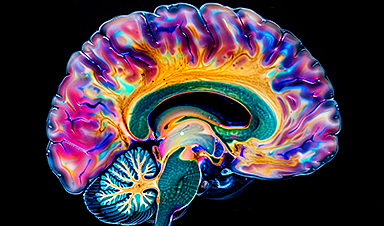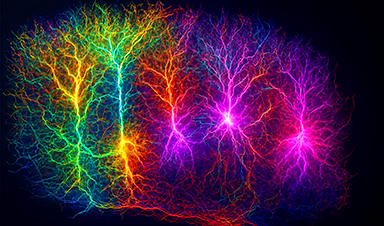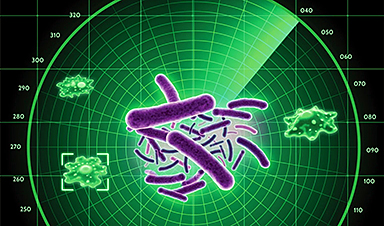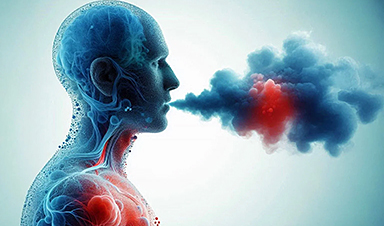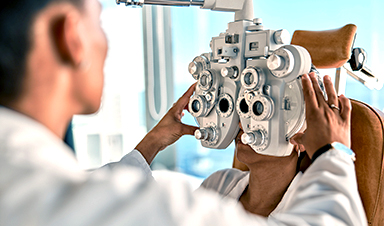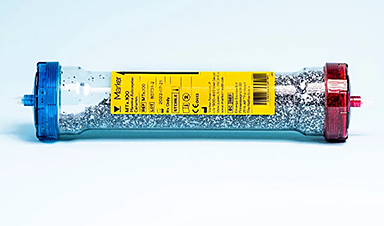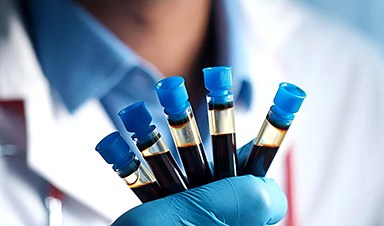Researchers have discovered that the SARS-CoV-2 spike protein persists in the brain and skull bone marrow for years after infection, potentially leading to chronic inflammation and neurodegenerative diseases.
Researchers from Helmholtz Munich and Ludwig-Maximilians-Universität (LMU) have uncovered a possible explanation for the neurological symptoms associated with Long COVID. Their study reveals that the SARS-CoV-2 spike protein can persist in the brain’s protective layers (the meninges) and the skull’s bone marrow for up to four years after infection. This lingering spike protein may drive chronic inflammation and heighten the risk of neurodegenerative diseases.
Led by Prof. Ali Ertürk, Director of the Institute for Intelligent Biotechnologies at Helmholtz Munich, the research also found that mRNA COVID-19 vaccines significantly reduce spike protein buildup in the brain. Despite this reduction, spike proteins that remain in the skull and meninges after infection could be targeted by new therapeutic approaches to mitigate long-term effects.
Spike Protein Accumulates in the Brain
A novel AI-powered imaging technique developed by Prof. Ali Ertürk’s team provides new insights into how the SARS-CoV-2 spike protein affects the brain. The method renders organs and tissue samples transparent, enabling the three-dimensional visualization of cellular structures, metabolites, and, in this case, viral proteins. Using this technology, the researchers uncovered previously undetectable distributions of spike protein in tissue samples from COVID-19 patients and mice.
The study, published in the journal Cell Host & Microbe, revealed significantly elevated concentrations of spike protein in the skull’s bone marrow and meninges, even years after infection. The spike protein binds to so-called ACE2 receptors, which are particularly abundant in these regions.
“This may make these tissues especially vulnerable to the long-term accumulation of spike protein,” explains Dr. Zhouyi Rong, the study’s first author. Ertürk adds, “Our data also suggest that persistent spike protein at the brain’s borders may contribute to the long-term neurological effects of COVID-19 and Long COVID. This includes accelerated brain aging, potentially leading to a loss of five to ten years of healthy brain function in affected individuals.”
Impact of Vaccination on Spike Protein Levels
The Ertürk team discovered that the BioNTech/Pfizer mRNA COVID-19 vaccine significantly reduces the accumulation of spike protein in the brain. Other mRNA vaccines or vaccine types, such as vector- or protein-based vaccines, were not investigated. Mice vaccinated with the mRNA vaccine showed lower levels of spike protein in both brain tissue and the skull’s bone marrow compared to unvaccinated mice. However, the reduction was only around 50%, leaving residual spike protein that continues to pose a toxic risk to the brain.
“This reduction is an important step,” says Prof. Ertürk. “Our results, while derived from mouse models and only partially transferable to humans, point to the need for additional therapies and interventions to fully address the long-term burdens caused by SARS-CoV-2 infections.” Furthermore, additional studies are needed to evaluate the relevance of these findings for Long COVID patients.
Challenges and Advances in Long COVID Treatment
Globally, 50 to 60 percent of the population has been infected with COVID-19, with five to ten percent experiencing Long COVID. This sums up to approximately 400 million individuals who may carry significant amounts of spike protein
“This is not just an individual health issue – it is a societal challenge,” says Prof. Ertürk. “Our study shows that mRNA vaccines significantly reduce the risk of long-term neurological consequences and offer crucial protection. However, infections can still occur post-vaccination, leading to persistent spike proteins in the body. These can result in chronic brain inflammation and an increased risk of strokes and other brain injuries, which could have substantial implications for global public health and healthcare systems worldwide.”
Diagnosing and Treating Long COVID
“Our findings open new possibilities for diagnosing and treating the long-term neurological effects of COVID-19,” says Ertürk. Unlike brain tissue, the skull’s bone marrow and meninges – areas prone to spike protein accumulation – are more accessible for medical examinations.
Combined with protein panels – tests designed to detect specific proteins in tissue samples – this could allow for the identification of spike proteins or inflammatory markers in blood plasma or cerebrospinal fluid. “Such markers are critical for the early diagnosis of COVID-19-related neurological complications,” Ertürk explains. “Additionally, characterizing these proteins may support the development of targeted therapies and biomarkers to better treat or even prevent neurological impairments caused by COVID-19.”
Highlighting the broader impact of the study, leading Helmholtz Munich and Technical University of Munich virologist Prof. Ulrike Protzer adds: “Given the ongoing global impact of COVID-19 and the increasing focus on long-term effects, this study, which sheds light on brain invasion pathways and unexpected long-term host involvement, is timely. These critical insights are not only scientifically significant but also of great interest to society.”
Reference: “Persistence of spike protein at the skull-meninges-brain axis may contribute to the neurological sequelae of COVID-19” by Zhouyi Rong, Hongcheng Mai, Gregor Ebert, Saketh Kapoor, Victor G. Puelles, Jan Czogalla, Senbin Hu, Jinpeng Su, Danilo Prtvar, Inderjeet Singh, Julia Schädler, Claire Delbridge, Hanno Steinke, Hannah Frenzel, Katja Schmidt, Christian Braun, Gina Bruch, Viktoria Ruf, Mayar Ali, Kurt-Wolfram Sühs, Mojtaba Nemati, Franziska Hopfner, Selin Ulukaya, Denise Jeridi, Daniele Mistretta, Özüm Sehnaz Caliskan, Jochen Martin Wettengel, Fatma Cherif, Zeynep Ilgin Kolabas, Müge Molbay, Izabela Horvath, Shan Zhao, Natalie Krahmer, Ali Önder Yildirim, Siegfried Ussar, Jochen Herms, Tobias B. Huber, Sabina Tahirovic, Susanne M. Schwarzmaier, Nikolaus Plesnila, Günter Höglinger, Benjamin Ondruschka, Ingo Bechmann, Ulrike Protzer, Markus Elsner, Harsharan Singh Bhatia, Farida Hellal and Ali Ertürk, 29 November 2024, Cell Host & Microbe.
DOI: 10.1016/j.chom.2024.11.007
News
5 Key Facts About Nanoplastics and How They Affect the Human Body
Nanoplastics are typically defined as plastic particles smaller than 1000 nanometers. These particles are increasingly being detected in human tissues: they can bypass biological barriers, accumulate in organs, and may influence health in ways [...]
Measles Is Back: Doctors Warn of Dangerous Surge Across the U.S.
Parents are encouraged to contact their pediatrician if their child has been exposed to measles or is showing symptoms. Pediatric infectious disease experts are emphasizing the critical importance of measles vaccination, as the highly [...]
AI at the Speed of Light: How Silicon Photonics Are Reinventing Hardware
A cutting-edge AI acceleration platform powered by light rather than electricity could revolutionize how AI is trained and deployed. Using photonic integrated circuits made from advanced III-V semiconductors, researchers have developed a system that vastly [...]
A Grain of Brain, 523 Million Synapses, Most Complicated Neuroscience Experiment Ever Attempted
A team of over 150 scientists has achieved what once seemed impossible: a complete wiring and activity map of a tiny section of a mammalian brain. This feat, part of the MICrONS Project, rivals [...]
The Secret “Radar” Bacteria Use To Outsmart Their Enemies
A chemical radar allows bacteria to sense and eliminate predators. Investigating how microorganisms communicate deepens our understanding of the complex ecological interactions that shape our environment is an area of key focus for the [...]
Psychologists explore ethical issues associated with human-AI relationships
It's becoming increasingly commonplace for people to develop intimate, long-term relationships with artificial intelligence (AI) technologies. At their extreme, people have "married" their AI companions in non-legally binding ceremonies, and at least two people [...]
When You Lose Weight, Where Does It Actually Go?
Most health professionals lack a clear understanding of how body fat is lost, often subscribing to misconceptions like fat converting to energy or muscle. The truth is, fat is actually broken down into carbon [...]
How Everyday Plastics Quietly Turn Into DNA-Damaging Nanoparticles
The same unique structure that makes plastic so versatile also makes it susceptible to breaking down into harmful micro- and nanoscale particles. The world is saturated with trillions of microscopic and nanoscopic plastic particles, some smaller [...]
AI Outperforms Physicians in Real-World Urgent Care Decisions, Study Finds
The study, conducted at the virtual urgent care clinic Cedars-Sinai Connect in LA, compared recommendations given in about 500 visits of adult patients with relatively common symptoms – respiratory, urinary, eye, vaginal and dental. [...]
Challenging the Big Bang: A Multi-Singularity Origin for the Universe
In a study published in the journal Classical and Quantum Gravity, Dr. Richard Lieu, a physics professor at The University of Alabama in Huntsville (UAH), which is a part of The University of Alabama System, suggests that [...]
New drug restores vision by regenerating retinal nerves
Vision is one of the most crucial human senses, yet over 300 million people worldwide are at risk of vision loss due to various retinal diseases. While recent advancements in retinal disease treatments have [...]
Shingles vaccine cuts dementia risk by 20%, new study shows
A shingles shot may do more than prevent rash — it could help shield the aging brain from dementia, according to a landmark study using real-world data from the UK. A routine vaccine could [...]
AI Predicts Sudden Cardiac Arrest Days Before It Strikes
AI can now predict deadly heart arrhythmias up to two weeks in advance, potentially transforming cardiac care. Artificial intelligence could play a key role in preventing many cases of sudden cardiac death, according to [...]
NanoApps Medical is a Top 20 Feedspot Nanotech Blog
There is an ocean of Nanotechnology news published every day. Feedspot saves us a lot of time and we recommend it. We have been using it since 2018. Feedspot is a freemium online RSS [...]
This Startup Says It Can Clean Your Blood of Microplastics
This is a non-exhaustive list of places microplastics have been found: Mount Everest, the Mariana Trench, Antarctic snow, clouds, plankton, turtles, whales, cattle, birds, tap water, beer, salt, human placentas, semen, breast milk, feces, testicles, [...]
New Blood Test Detects Alzheimer’s and Tracks Its Progression With 92% Accuracy
The new test could help identify which patients are most likely to benefit from new Alzheimer’s drugs. A newly developed blood test for Alzheimer’s disease not only helps confirm the presence of the condition but also [...]
